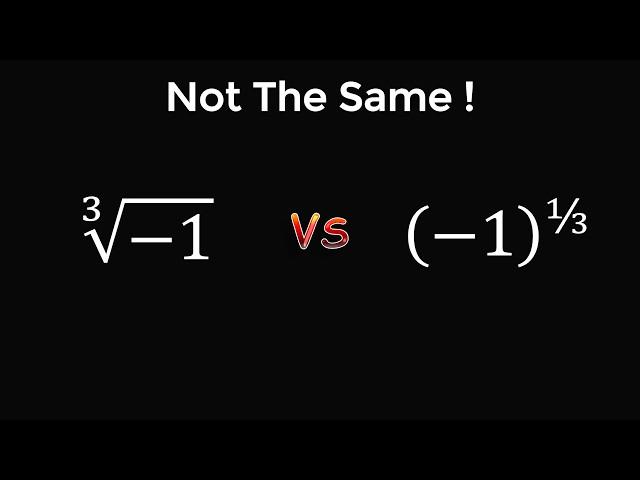
How are they different? Cube root vs the exponent of 1/3
Комментарии:

In class I was taught that n√x has only 1 solution and x^1/n is not the same as n√x since it has n solutions. Is it correct?
Ответить
The problem was poorly defined.
By stating x < 0, most people beside mathematicians assume real numbers by default while WA assumes complex numbers by default.
x ∈ ℂ should have been stated up front.

So is (x)^(1/2)=c solution and (x)^(1/2)=-1 still holds value for x=1,because (1)^(1/2)=±1 in complex realm? See that in complex realm you can't say which number is larger than the other.
Ответить
They are both equal to ½+(√3/2)i
Ответить
Therefore √x (cube root) does not equal x⅓, where x belongs to the set of real numbers
Ответить
We're echo the long echo of each other..
Ответить
In my country you are not allowed to put negative numbers inside the cube root
Ответить
When I was studying Mathematics, one of the way we avoided this confusion was we had to say what domain is x in and what domain is the answer in and how many solutions we want.
For example, solve the equation x^2+2=1 where x is in the set of Real Number. The answer is no solution because there is no real value x that will solve this.
If I said, "Solve for x^3+2=1 where x is in the set of Real Number", now you know there is one solution and it is -1. If I change it to, "Provide all solutions of x of the following equation where x^3+2=1 and x is in the set of Complex Numbers", now you know to give me all of the solutions that this video mentioned.
This was especially important in abstract algebra and complex analysis class (class just focused on complex numbers).

There are 3 cube root to a cubic equation. There are n roots to n degree equation.
Ответить
But they are the same, they both have the same solutions, am i missing something?
Ответить
sqrt(2) times sqrt(2) is 2, but 1.41421356237 times 1.41421356237 is approx. 2 (1.9999....) so why when we draw a square with a side a = 1, it can be shown on paper, but its diagonal is = a*sqrt(2), so it is irrational. The same situation with a circle, how can we draw some circle "X", if Pi (circle or disc circumference) is irrational too: 3.141592....
Ответить
√ is a MULTIVALUED function
Ответить
The distinction is arbitrary and unfounded. You're grasping at straws.
Ответить
You describe the process of taking multiple roots as "not being a function". I don't think this is correct. It's not injective, but a non-injective function can still be called a function. I would also argue that the most correct solution to taking roots (with either notation) is to list all roots, not just the principal root. i.e.
√4=±2 and 4^(1/2)=±2. If you want to take only the principal root, you can use either notation to do so but should describe your choice to do so if it is not already obvious from the context (e.g. if you are working with physical objects, it may already be obvious that the solution space is constrained to the reals or to the non-negativite reals).

You sound somewhat angry in the video. Is everything okay?
Ответить
It's bs. I checked this site and if you choose "the real-valued root" in both cases you wil get "-1" in both cases, if you choose "the principal root" in both cases you will get (1/2)+(sqrt(3)/2)*i in both cases. This video is senseless.
Ответить
I love squareroot 😊
Ответить
"sqrt(x) is not a function" - You wouldn't pass an exam, be it in high school or complex analysis at a university...
Ответить
Let's always do alot of good 🙏
Ответить
Why does this man's shorts have stuff like the most basic fraction addition ever, but then his long form vids don't explain what's happening? Like, where'd the circle came from, and why is there some angle there?
Ответить
So they got the ordinary real and the complex cube root functions mixed up - normally they would mean the same thing for REAL functions.
They Wolfram people should make it possible to specify, which type of the cube root function (etc. ) you mean in the specific case in question.

The fact is both of those answers are right, as they are 2 of the right 3 answers. It's easier to solve this puzzle is with polar coordinates. Recall that -1 is also 1@180 degrees. Take the cube root and the first answer is 1@60 degrees, the second is 1@180 degrees or -1, and the third answer is 1@300 degrees, or 1@-60 degrees.
Ответить
Mean while back at the farm........
the battle of conventions rages on!

Huh?
Ответить
If y = f(x) has several solutions for one unique x then f() is not a function and we do not have the right to apply the rules defined for a function.
First case, in ℂ (complex domain) y=x³ is a function but the inverse relation x = g(y) is not a function since there are 3 solutions for x from an unique y. So each writing considering that a specific solution among the three ones is THE solution is wrong.
Then both writings of the video (-1)^(1/3) and ³√(-1) are wrong, and if you use them it is not surprising that you discover inconsistencies depending on what the “software decides to perform”.
If a specific software considers one unique solution, for example y=-1, like x= -1 in one writing and x=+1/2+ √3/2.i for a second one (what about x=+1/2-√3/2.i?) probably that you should not trust nor use this software.
Second case in ℝ
The radical fonction √x is defined for x Є ℝ+ and not defined when x Є ℝ-* . We can generalize this approach for each even radical order.
The problem is when the radical order is odd since there is a solution and a unique one even when x is negative. Then, it probably depends on the school, the teacher and the country, but generally it is admitted to avoid using the radical notation whatever the order and whatever the sign of x.
It is the most consistent approach since sometimes the sign of x and/or the parity of the radical order are not immediately obvious. So, even if not confusing here, the notation ³√(x) for x negative should be considered illegal, to avoid confusion at least.

"=" means "equivelant to." It does not mean the exact same thing. It means they're for the intent and purpose at hand, interchangeable. 1 Apple is not the same as 1 banana but we can still say 1=1.
Ответить
Each number can be thought of as vector in the complex plane. The product of vector V and a unit vector U = exp(i * theta) is a rotated version of V. (In fact, the rotation is theta radians counterclockwise about the origin.) The vector "-1" is just exp(i*pi). So, a geometric interpretation of the solution to U^3 = exp(i*pi) is "what unit vector -- when rotated by itself twice -- results in the vector exp(i*pi)?" Clearly, a unit vector having angle pi/3 (60 degrees), when rotated by itself counterclockwise twice, results in a vector with angle 60 + 60 + 60 = 180 degrees. exp(i*pi/3) is the principle root you found. Note also that the vector (i*(-pi/3)) is also a root: if we rotate it twice using itself we also reach exp(i*(-pi)) = exp(i*pi). However, in this case the rotation is negative (clockwise).
Ответить
Proof that 0 = 1 ;-
1^0 = 1
1^1 = 1
1^0 = 1^1 = 1
1^0 = 1^1
It is in the form of the formula a^m = a^n => m = n
So,
0 = 1 !!!!

Obviously this notation is confusing. You need to define at first the domain whether it's ℝ or ℂ.
Ответить
The million dollar question: what is cuberoot(r•exp(i•(theta+2•pi•k))) ? 🤔
Ответить
I'm taking complex analysis in university right now. This is the first subject. If you say (-1)^1/3=Z then z^3=-1. With moivre formula you can find 3 roots. So 3 answers, all true and will give you -1.
Ответить
One really important part (briefly mentioned) is, that the convention is one thing, but often what matters is the context for a particular problem. The other thing is, that conventions may differ, so sometimes (e.g. when writing a paper) the question arises, how to express something unambiguously without much hassle.
Ответить
Isn’t it??
1/ (-1)^1/3

PLEASE quote authoritative sources, books and send details fir your statement.
As discussion,
1. Why we have two notations x^(1/2) and √x if they are same ...??
If they are same why not have more notation, why only two? Each thing is done with a purpose, isn't it ..
2. If x^1/3 refers to positive 3rd root of x , x real, then why people write,
a^3=1, raise to power 1/3 on both sides, a=1^1/3 !!!
if former ( a^3 =1) refers, in a way, to collection of roots, put in the form of equation then, why not latter ?
3. If (-1)^1/3 or for complex no. z, if z^1/3 refers to collection of 3 roots and complex is extension of reals then, does concept change on expansion of number system or there should be harmonious extension of concept ??
OR IS IT THAT,
WE should write positive 4 th root of unity as 4√1, with 4 inside radical sign while 1^(1/4) refers to collection of 4 roots !!!
LET US HAVE A LOGICAL EXPLANATION.
Is it that it has become the practice to use 2^3/5 to denote only real just due to compulsions of laws of exponents...
Eg. In context if progressions, the centuries old books of hall and knight and euler etc state, common difference non zero etc...terms should keep changing while these days, people allow common difference to be zero as per convenience. Abuse of definition isn't justifiable as extension of definition.
,

Wrong and false. It's a mistake to think that roots only apply on real values and fractional exponents on complex ones. Roots and fractional exponents are (2 different notations of) the same thing
Ответить
It is misleading to claim that two different notations have different semantics, just because in some contexts, different conventions are used. Strictly speaking, any equation that is supposed to show the result of evaluating the expression (in whatever notation) that only shows one of the multiple solutions is wrong, irrespective of any convention.
Ответить
Typical no-value article with title to attract people.
Ответить
This is a very good and clear explanation of the problem.
Multi-valued functions is maybe a amusement for some theory gurus, but if you need to make calculation, you should simply ignore them and consider either the principal value, which is well defined, or the real value if exist, as explained here.
The root symbol is basically used only for the n-th root with n natural (that means exponent is 1/n). We can extend easily to any rational exponent.
But you can always write exponentiation operation where exponent is irrational ... if you apply multi-valued operators to (-1)^pi for example, then you're in big trouble, because there are an infinity of values. The whole unit circle is solution ...

How do you get negative numbers from y=sqrtX?
Ответить
There are real imaginary numbers, then the are imaginary imaginary numbers...
Ответить
The polar form of e^i*pi+2*pi*k should have parenthesis, e^i(pi+2*pi*k)
Ответить
One runs into ambiguity when the base is negative and the exponent is fractional. The core of the issue is that a^b is defined as exp(b ln a) when b is not an integer. And ln a is not uniquely defined for anything but a > 0. Wolfram's behavior generalizes better than "take the real root, if one exists".
Ответить
They are the same, it is just different notation. We need dislikes back...
Ответить
because there exists three different values of this equation 😂that’s all
Ответить
Nicely done - Both cube root and exponents are human constructs suspectable to paradox - that can only be resolved by exploring their constructs - and you did that "expertly"
Ответить
great video. Coincidentally I got to know that such thing as complex plane exists a few days ago, so the concept was easier to understand.
Ответить

























